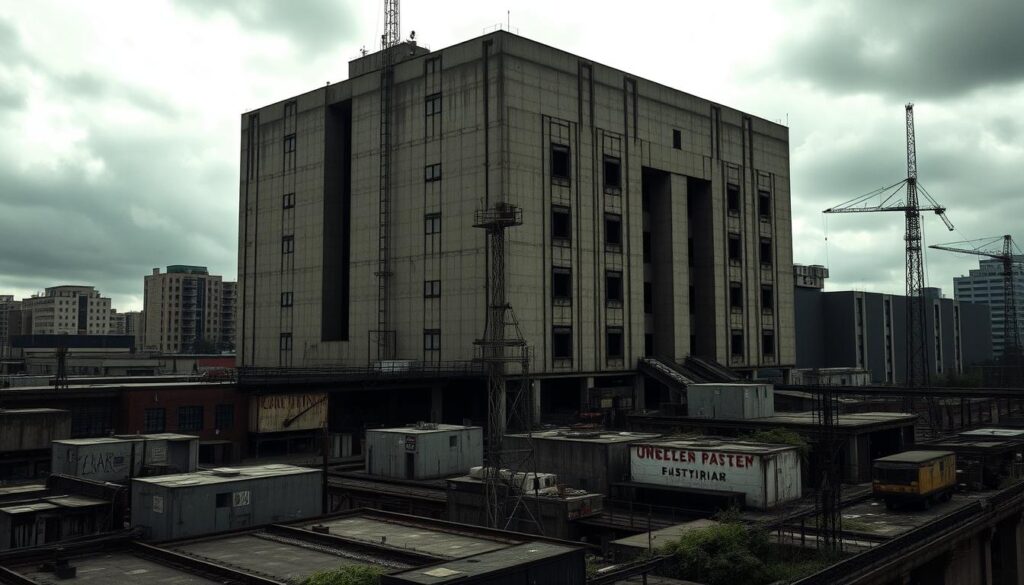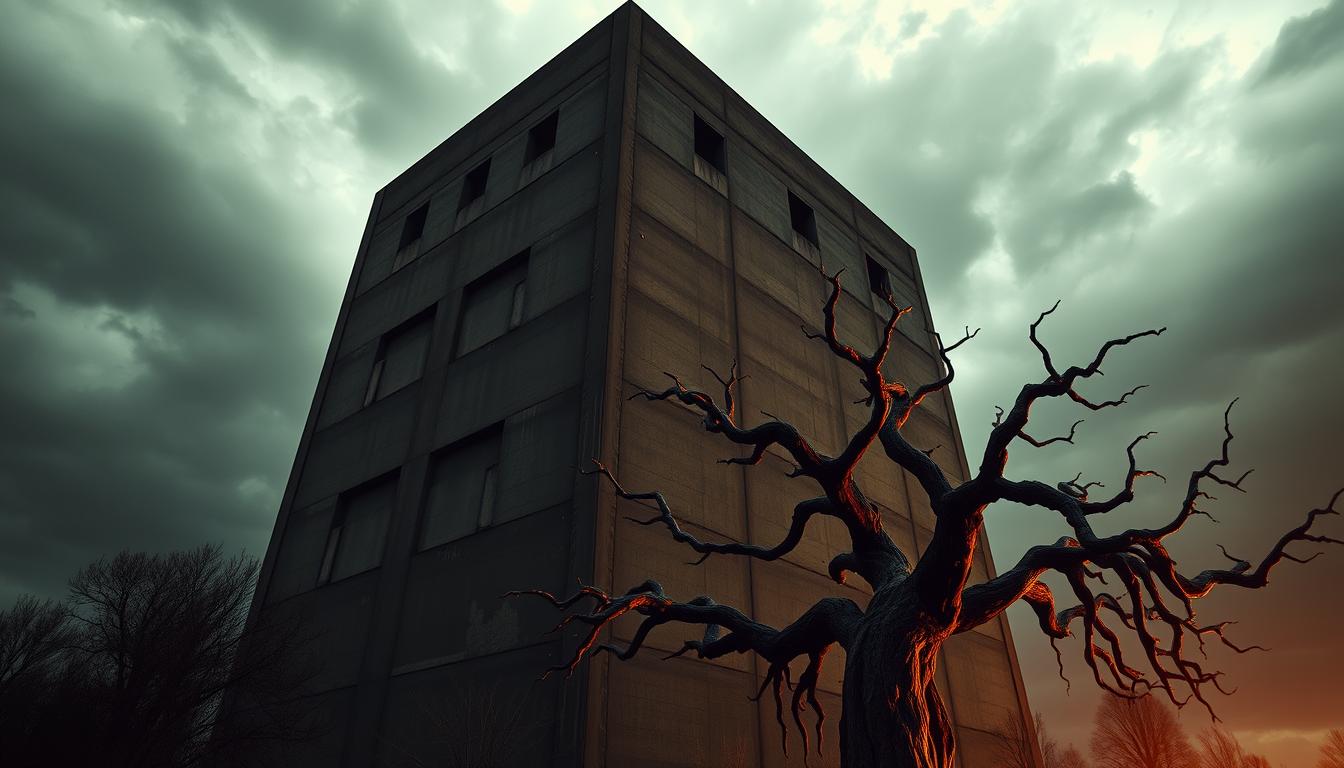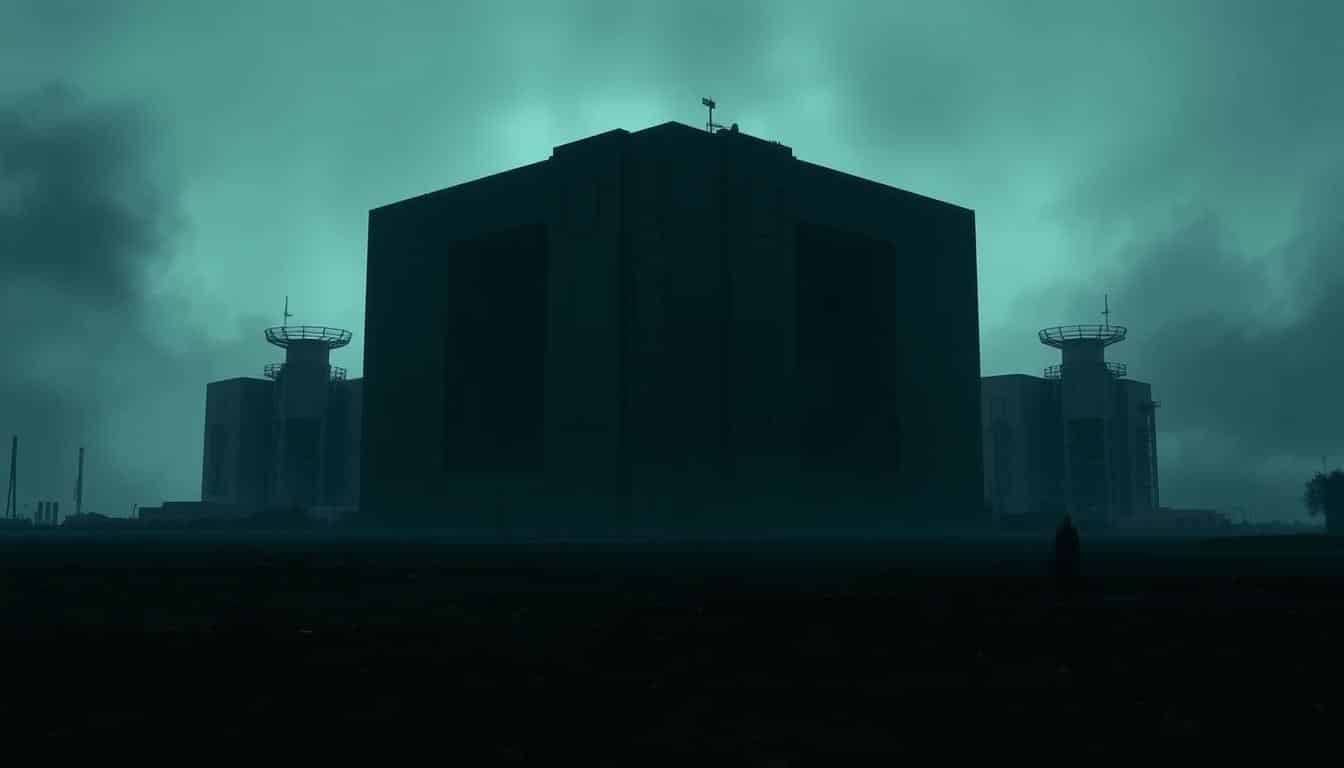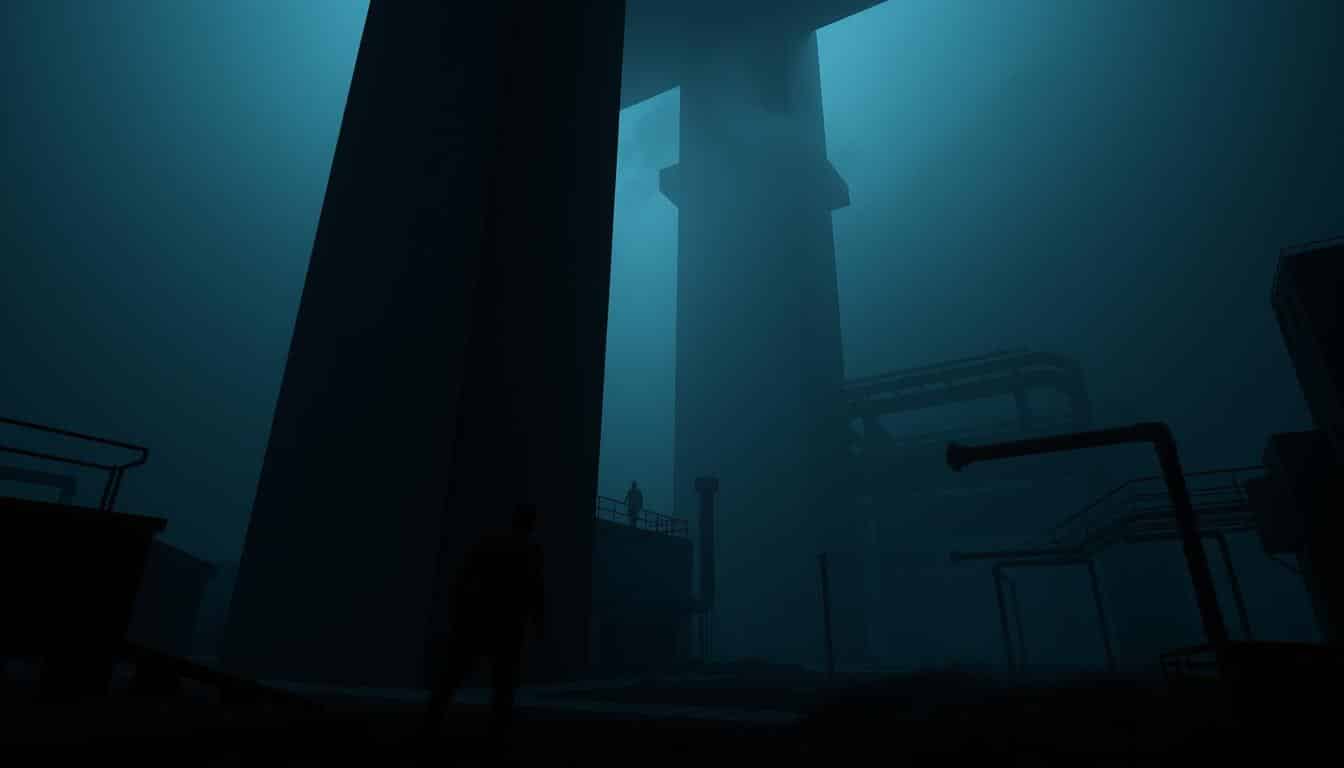Exploring fear in brutalist games is exciting for both players and critics. Brutalist architecture and digital experiences come together here. They create spooky environments that grab your attention.
The design features of brutalism make the atmosphere full of tension and unease. We look at how architecture can make us feel scared. This shows the big effect design has on how we feel when playing.
The Architectural Influence of Brutalism on Gaming
Brutalism began in the mid-20th century. It’s known for its bold, rugged look and fortress-like buildings. This style often makes people feel uneasy. It plays a big part in games today. In gaming, brutalist designs are more than just backgrounds. They help tell the story and make the game feel more real.
In gaming, the way buildings are designed is important. It changes how players move and explore. “Dishonored” is a great example, with a world inspired by brutalism. Players walk through spaces that feel real and heavy. The buildings show themes like power and loneliness.
The stark look of brutalism adds to the game’s mood, making players feel on edge. Games use this design to make players face the tough world around them. They often look like big, empty cities. This pushes players to look deeper and find the dangers that are hidden away.

Understanding the Psychology of Fear in Game Design
The psychology of fear in games is key to keeping players hooked and feeling intense emotions. Game designers use fear to make game environments that make players feel anxious and excited. They rely on psychological principles to affect how players see their surroundings. Quick audio cues or sudden visual changes, for example, can make players extra alert.
Environmental cues are really important for causing fear, and it’s not just about direct threats. The design of a space can make players feel scared or trapped. This is especially true in games inspired by brutalist architecture, which uses stark designs to increase discomfort. The strong contrasts in these environments can make players feel pulled to explore, even though they’re scared of what they might find.
Surprises also add a lot to the psychology of fear in games. Creating moments where players feel safe, then suddenly threatened, keeps emotions running high. Game developers that get these psychological elements right can make gaming experiences that deeply affect players. This makes the game more engaging and the emotional journey more profound.
Architectural Uncanniness: A Key Component of Fear
Architectural uncanniness shapes the emotional landscape of video games in a big way. It happens when familiar settings make us feel uneasy. Players often feel scared in places that look normal but are slightly off. This twist on what we’re used to creates spooky spaces in games, which unsettle and fascinate us.
Game developers use these eerie spaces to dial up the fear. They include things like:
- Unusual layout or design that feels illogical.
- Desolate urban settings devoid of life.
- Spaces that appear familiar yet distort basic spatial reasoning.
This approach to game design makes us dive deeper into worlds where nothing is as it seems. It sticks with us as we move through game worlds, facing our fears. The way architectural uncanniness plays with our minds adds a deep, memorable layer to gameplay.
The Role of Absence in Creating Unease
In game design, the lack of something plays a big part in impacting how players feel. It can make them feel scared and lost. Places with nothing in them make players feel uneasy. They have to figure out how to deal with these feelings.
The idea is that absence isn’t just nothing. It’s something that can actually add to the environment’s mood. This makes the game feel more tense for the player. When players see an empty space, they might wonder what used to be there. Or what might still be hiding around.
- Empty spots can hint at something missing, letting players use their imagination.
- Silence can seem scarier than noise, making the game feel more intense.
- In empty places, players might worry about hidden dangers.
The way absence is used in games can really make them feel eerie. By focusing on what’s not there, game makers can make players more anxious. This makes games more engaging because it draws players into a world that’s both intriguing and spooky.
Analyzing the Fear Factor in Brutalist-Inspired Games
Games with brutalist designs really stand out when it comes to making players feel scared. These games mix architecture with psychology to spark fear. Some well-known games show that the way a building is designed can make people more emotional. This happens through how spaces are arranged, how light is used, and the details of the setting.
Case Studies of Games Utilizing Brutalist Aesthetics
Many games use brutalist designs to create a spooky vibe. For example, “Dishonored” has buildings that make you feel small and nervous. It uses big, imposing structures and sharp contrasts to bring out feelings of discomfort. Moshe Linke’s games also use space cleverly to make you feel tense. These examples prove that the design of the game world is crucial in making things feel more scary, pulling from deep fears we all have.
How Design Choices Amplify Psychological Fear
The way a game is designed has a big impact on how scary it feels. Lighting is super important. It creates deep shadows, hiding dangers and making things more suspenseful. The way a space is laid out can make you feel trapped and exposed. Also, a game’s story can draw you in deeper, making everything feel more real and terrifying. All these design elements work together in brutalist games to really push on our natural fears.
The Effect of Liminal Spaces in Game Environments
Liminal spaces in gaming are key for making games feel real and engaging. They bring a sense of change, making players feel lost and uneasy. Think about wandering through an empty mall, a forgotten amusement park, or empty hallways. These places seem empty but are rich with possibilities. They make the game feel both familiar and strangely unsettling.
When we look closer at these spaces, we see their role in telling a story in games. They create pauses in the story, suggesting a change is coming. Moving through these uncertain places, players feel more exposed to danger. This fear makes the game even more thrilling, especially in horror games. Game makers use these spaces to touch our emotions, drawing us deeper into the game.
Architectural Surveillance: The Panopticon Effect
Games use architectural surveillance, inspired by the panopticon effect, to make players feel always watched. This constant observation changes how players interact with the game, making them really think about where they are and what they do. Things like clear lines of sight, mirrors, and tight spaces are used to make this feeling stronger. They mix tension with the game’s flow.
Impacts of Surveillance Elements on Gameplay
Surveillance changes how players act. Knowing they might be watched, players tend to be more careful and think hard about their moves. The effects include:
- Fear and worry, as players think over each step.
- Better focus, because dodging watchful eyes keeps players hooked.
- New strategies, like sneaking or staying out of sight.
This kind of game design doesn’t just make players uneasy. It also adds depth to the game’s story and pulls players into a more intense emotional journey.
The Unsettling Nature of Abandonment in Game Design
Games use the theme of abandonment to affect how players feel. Places that look empty can make us feel really uneasy. These spots share their stories with us, making us think about what was left behind.
Imagine finding deserted houses, schools no one goes to, and scary places. This silence and the echoes of the past make us feel alone. Things like old toys or notes add to the mystery, making the game more than just a game.
Remembering the past makes games feel more intense. Every item tells a story, connecting us to the game emotionally. It makes us scared and thoughtful, caught up in the quiet tales of what’s been forgotten. This helps us see how tough it can be to feel left behind.
Spatial Hauntings and Their Emotional Impact
Spatial hauntings in games create atmospheres filled with emotional depth. They reflect the heavy weight of past events in the architecture. Hauntings do more than fill the atmosphere; they deeply touch gameplay and player emotions. They let players explore physical and psychological landscapes.
Understanding how these elements combine shows the fear and anxiety in these digital spaces. It reveals how fear and anxiety weave through these environments.
Examples of Haunted Spaces in Popular Games
Many games offer amazing examples of spatial hauntings that bring strong emotions. For example:
- Silent Hill 2: The town is a symbol of guilt and trauma, with locations full of emotional history.
- Amnesia: The Dark Descent: The castle, with its dark corners and whispers, becomes a living part of the player’s journey.
- House of Ashes: A military base underground becomes a place of terror, reacting to player choices.
The Role of Objects in Eliciting Fear
Objects in haunted places carry symbols of fear and loss. Simple items can become sources of dread, making the emotional impact stronger. Their placement and state tell stories, causing players to react strongly. A child’s toy in a dark corner can bring up feelings of lost innocence.
Discarded photographs can make players curious but also afraid. This connection between objects and hauntings draws players into the game’s psychological terrors.
Breaking Architectural Logic: Distorted Spaces
In games, twisted architecture helps players dive into strange and unsettling worlds. They face weird layouts, like staircases to nowhere or rooms arranged in impossible ways. These oddities twist reality, making players feel lost.
These spaces can make you feel scared and confused. They’re like something from a horror movie or book. When you wander through them, you might start to wonder if anything in the game is real. This can make you feel more afraid because you feel like you’ve lost control.
Game makers use these warped designs to make stories more gripping. They make you question what’s around you, connecting the game’s story to deeper themes. It’s not just about looking cool; it makes the game feel more alive and touching.
The Narrative Power of Brutalism in Game Worlds
Games use brutalist design to tell deep stories. This style’s stark, bare look deeply affects players’ feelings. It sets a scene that reflects themes of feeling alone and strong, pulling players into stories that are rich and full.
Games with brutalist designs make us feel strong feelings through their buildings. The big structures and basic materials are not just for looks. They show the struggles of characters and how societies can fall apart. Players move through lonely, crumbling places, feeling a connection to the story.
These design choices act as symbols for inner fights. Going through brutalist game worlds, players face sadness and loneliness. This shows how important it is to use brutalist styles in games to connect playing with storytelling. Developers use these designs on purpose, making stories that touch players in many ways.
Conclusion
In conclusion, brutalist games use unique architecture to dive deep into the concept of fear. These games combine design and psychology. This blend makes players feel uneasy, creating a memorable experience. The choice of architecture, from stark scenes to weird spaces, is key. It shapes how we feel while playing, making fear in games stand out.
Brutalist architecture and emotions work together to make stories that pull us in. By seeing how players react to these spaces, game makers can create deeper gameplays. These games test player skills and touch their feelings. This wrap-up shows how adding architectural ideas to game design can make games more engaging emotionally.
The gaming world keeps changing, and using brutalist principles can lead to new, exciting games. These games do more than entertain; they make us think and feel. This push for games that affect our feelings could inspire designers to explore new ways spaces impact us emotionally. We might see games that feel more real and moving.



